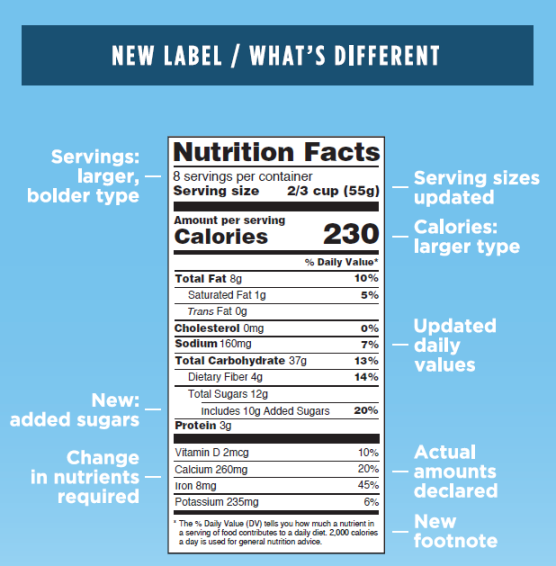By Sheridan Wimmer on November 5, 2019
Meet Your New Nutrition Label
Updated research on food products and nutritional needs of consumers means an updated nutrition label will be coming soon to a grocery store near you.

If being an adult means getting upset when they rearrange your grocery store, then get ready for another change happening in grocery stores across America. However, these changes shouldn’t be as jarring as finding bacon where the breakfast rolls used to be, and they’ll provide a positive, even helpful, shopping experience.
New food labels are coming. They’ll be bigger, bolder and provide information necessary for making choices based on individuals’ dietary needs or preferences. Food manufacturers with $10 million or more in annual sales will have until Jan. 1, 2020, to comply with the new food labels. Those manufacturers with less than $10 million in sales have until Jan. 1, 2021. Single-ingredient sugar manufacturers (honey, maple syrup) have until July 1, 2021.
The changes reflect updated scientific information from the U.S. Food and Drug Administration (FDA) and will be easier for consumers to understand.
“The changes you’ll see on nutrition labels are a testament to the importance of science and research in food products,” Karen Hanson, a consulting dietitian, says. “Changes like these help food purchasers make better choices based on their health needs, restrictions or preferences.”
SIZE UP SERVINGS
The change: The number of “servings per container” and the “serving size” declaration are now in larger and/or bolder type. Servings per container shows the total number of servings in the entire food package. According to the FDA, some containers may have a label with two columns — one shows the amount of calories and nutrients in one serving; the other column shows information for the entire package.
Serving sizes have been updated to reflect what people customarily eat and drink at one time. For example, the serving size for ice cream was previously 1/2 cup and now is 2/3 cup.
“This change is helpful to be more realistic in expectations, but it is not a recommendation of how much to eat,” Hanson points out. “When comparing calories and nutrients in different foods, check the serving size in order to make an accurate comparison.”
BURNING AND EARNING CALORIES
The change: “Calories” is now larger and bolder. The FDA proposes that “as a general guide: 100 calories per serving of an individual food is considered a moderate amount, and 400 calories or more per serving of an individual food is considered high in calories.”
“While calories aren’t everything one should care about when sizing up nutrition information, it’s beneficial to be able to see the count more easily," Hanson says. “We are all different and have different needs based on our activity levels, age, sex, height and weight. Balance the number of calories you consume with the number of calories your body uses.”
A TEASPOON OF SUGAR
The change: This change will include sugars that are either added during the processing of foods, or
are packaged as such (e.g., a bag of table sugar), and includes sugars from syrups and honey, and sugars from concentrated fruit or vegetable juices.
For example, milk or fruit contains natural sugars that make up a portion of the carbohydrates in them. Foods like ice cream, or jams or jellies made from milk and fruit, contain the naturally occurring sugars, but also contain added sugars. The new label will help people know how much of each is contained in a product.
“Sugar information is a major consideration when thinking about a healthy lifestyle,” Hanson says. “It gets confusing when products have natural sugars to compare those to artificial sugars and added sugars. This will help the purchaser better understand their sugar intake.”
The FDA suggests aiming for less than 10 percent of your total daily calories from added sugars.
A NEW NUTRIENT TEAM
The lists of nutrients required or permitted on the label have been updated. A lot of Americans don’t always get the recommended amounts of nutrients with their respective diets. Two of those nutrients, vitamin D and potassium, will be required on labels in order to help alleviate that inadequacy.
On the other hand, some deficiencies have proven rare, so vitamins A and C are no longer required on food labels. The actual amount (in milligrams or micrograms), in addition to the percent daily value (%DV), must be listed for vitamin D, calcium, iron and potassium.
Photo courtesy of the FDA
We can get used to these changes. And we’ll likely find the bacon the next time we shop. Just be sure to read the label, too.







